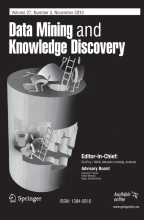Abstract
We describe how statistical association models and, specifically, graphical models, can be usefully employed to model web mining data. We describe some methodological problems related to the implementation of discrete graphical models for web mining data. In particular, we discuss model selection procedures.
Similar content being viewed by others
Explore related subjects
Discover the latest articles, news and stories from top researchers in related subjects.References
Breese, J., Heckerman, D., and Kadie, C. 1998. Empirical analysis of predictive algorithms for collaborative filtering. Proceedings of the 14th Conference on Uncertainty in Artificial Intelligence. New York: Morgan Kaufmann.
Brooks, S. 1998. Markov chain Monte Carlo method and its application. The Statistician, 47:69–100.
Giudici, P. and Castelo, R. 2001. Improving Markov chain Monte Carlo, for data mining. Manuscript revised for publication.
Giudici, P. and Green, P. 1999. Decomposable graphical Gaussian model determination. Biometrika, 86: 785–801.
Heckerman, D., Chickering, D., Meek, C., Rounthwaite, R., and Kadie, C. 2000. Dependency networks for inference, collaborative filtering and data visualization. Journal of Machine Learning Research, 1:49–75.
Heckerman, D., Geiger, D., and Chikering, D. 1995. Learning Bayesian networks: The combination of knowledge and statistical data. Machine Learning, 20:197–243.
Lauritzen, S. 1996. Graphical Models. Oxford: Oxford University Press.
Madigan, D. and York, J. 1995. Bayesian graphical models for discrete data. International Statistical Review, 63:215–232.
Whittaker, J. 1990. Graphical Models in Applied Multivariate Statistics. New York: Wiley.
Author information
Authors and Affiliations
Rights and permissions
About this article
Cite this article
Giudici, P., Castelo, R. Association Models for Web Mining. Data Mining and Knowledge Discovery 5, 183–196 (2001). https://doi.org/10.1023/A:1011469000311
Issue Date:
DOI: https://doi.org/10.1023/A:1011469000311
